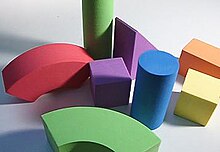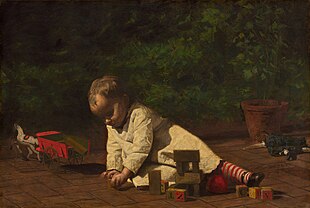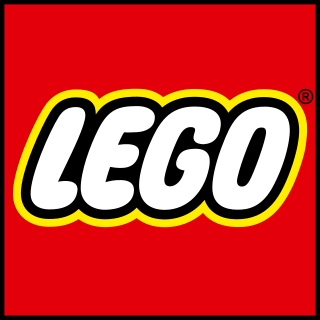
Lego is a line of plastic construction toys manufactured by the Lego Group, a privately held company based in Billund, Denmark. Lego consists of variously coloured interlocking plastic bricks made of acrylonitrile butadiene styrene (ABS) that accompany an array of gears, figurines called minifigures, and various other parts. Its pieces can be assembled and connected in many ways to construct objects, including vehicles, buildings, and working robots. Assembled Lego models can be taken apart, and their pieces can be reused to create new constructions.

A toy or plaything is an object that is used primarily to provide entertainment. Simple examples include toy blocks, board games, and dolls. Toys are often designed for use by children, although many are designed specifically for adults and pets. Toys can provide utilitarian benefits, including physical exercise, cultural awareness, or academic education. Additionally, utilitarian objects, especially those which are no longer needed for their original purpose, can be used as toys. Examples include children building a fort with empty cereal boxes and tissue paper spools, or a toddler playing with a broken TV remote control. The term "toy" can also be used to refer to utilitarian objects purchased for enjoyment rather than need, or for expensive necessities for which a large fraction of the cost represents its ability to provide enjoyment to the owner, such as luxury cars, high-end motorcycles, gaming computers, and flagship smartphones.

Lego Duplo is a core product range of the construction toy Lego by The LEGO Group, designed for children from 1+1⁄2 to 5 years old. Duplo bricks are twice the size of traditional Lego bricks, making them easier to handle and less likely to be swallowed by younger children. Despite their size, they are still compatible with traditional Lego bricks.
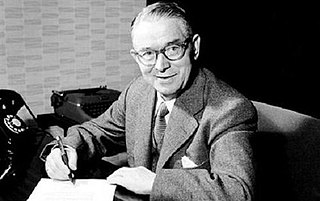
Ole Kirk Christiansen was a Danish carpenter. In 1932, he founded the construction toy company Lego, later known as The Lego Group. Christiansen transformed his small woodworking shop, which initially sold household products, into a manufacturer of wooden toys. By 1934, he had officially named the company Lego and established its fundamental principles. The business shifted to producing plastic bricks after the acquisition of a plastic moulding injection machine in 1947. Following his death in 1958, the company's management was handed over to his son, Godtfred.

This article lists notable events and releases in the history of the Lego Group.

The Froebel gifts are educational play materials for young children, originally designed by Friedrich Fröbel for the first kindergarten at Bad Blankenburg. Playing with Froebel gifts, singing, dancing, and growing plants were each important aspects of this child-centered approach to education. The series was later extended from the original six to at least ten sets of gifts.
The history of Lego began in 1932 in the carpentry workshop of Ole Kirk Christiansen, a Danish carpenter who initially produced furniture but later started making wooden toys. The company was named "Lego" in 1934, a contraction from the Danish phrase "leg godt", meaning "play well".

A construction set is a set of standardized pieces that allow for the construction of a variety of different models. Construction sets are generally marketed as toys. One very popular brand of construction set toys is Lego.

The LEGO Group is a Danish construction toy production company based in Billund, Denmark. It manufactures Lego-branded toys, consisting mostly of interlocking plastic bricks. The LEGO Group has also built several amusement parks around the world, each known as Legoland, and operates numerous retail stores.
Godtfred Kirk Christiansen was the managing director of The Lego Group from 1957 to 1973. He was the third son of company founder Ole Kirk Christiansen and took over as managing director in 1957, eventually becoming the sole owner. Godtfred is credited with playing a pivotal role in the development of the Lego brick design and patented it in 1958. He also created the Lego System in Play, the cornerstone of the Lego construction toy. Godtfred stepped down as Leader of the company in 1973. His son Kjeld Kirk Christiansen became president in 1979.

Mega Brands Inc. is a Canadian children's toy company that is currently a wholly owned subsidiary of Mattel. Mega Bloks, a line of construction set toys, is its most popular product. Its other brands include Mega Construx, Mega Puzzles, and Board Dudes. The company distributes a wide range of construction toys, puzzles, and craft-based products.

Tente is a line of construction toys created in 1972 by EXIN-LINES BROS S.A., a plastics and toy company based in Barcelona, Spain which ceased operation in 1993. The toys consist of multi-colored interlocking plastic bricks in multiple scales and an accompanying array of wheels, minifigures, and various accessories.

Educational toys are objects of play, generally designed for children, which are expected to stimulate learning. They are often intended to meet an educational purpose such as helping a child develop a particular skill or teaching a child about a particular subject. They often simplify, miniaturize, or even model activities and objects used by adults.

Jason Burik is an American Lego artist who builds custom replica models with interlocking plastic bricks. His work has been commissioned by professional sports teams, colleges, companies, and individuals in the United States.

Best-Lock Construction Toys is a brand of plastic building bricks that are compatible with Lego. Best-Lock Group Limited, which manufacture the bricks, is based in Colne, Lancashire, England.

A Lego clone is a line or brand of children's construction blocks which is mechanically compatible with Lego brand blocks, but is produced by another manufacturer. The blocks were originally patented by The Lego Group in 1961 as "toy building bricks", and the company has since remained dominant in this market. Some competitors have moved to take advantage of Lego brand recognition by advertising their own products as compatible with Lego, with statements such as "compatible with leading building bricks".
Since the introduction of the first Lego weapon in 1978, Lego has been criticised for the presence of weaponry and, consequently, the levels of violence presented within its product range. The relationship between Lego and violence has been a source of controversy, despite the fact that The Lego Group has maintained an ethos of not producing products that promote violence. The presence of toy weapons in Lego construction toys has increased over the years, with the introduction of many types of weapons across a variety of Lego themes.

EverBlock Systems, LLC. is a modular construction materials company headquartered in New York City, New York, with distribution networks worldwide. It develops, produces and markets the modular plastic blocks which are used in a variety of construction applications, both personal and commercial.
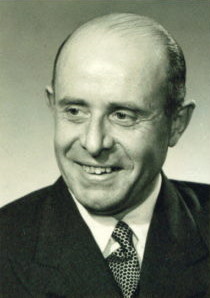
Hilary "Harry" Fisher Page was an English toy maker and inventor of Self-Locking Building Bricks, the predecessor of Lego bricks. He founded the Kiddicraft toy company.

Building blocks are modular construction parts, usually made of plastic, which can be assembled in a form-fit manner. The basic components are usually cuboid-shaped, cylindrically studded at the top in a grid pattern, hollow-bodied at the bottom and smooth at the sides. The structured upper surface interacts by friction and positive locking with the correspondingly negative lower surface of other clamping components, so that complex designs can be assembled. The design allows the parts to be connected with compressive force and the blocks to be clamped with plastic pins.
